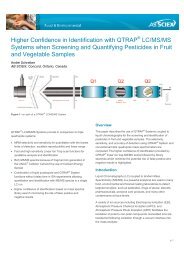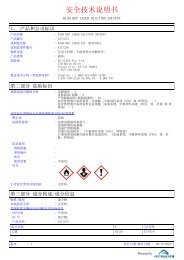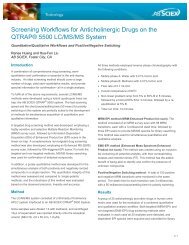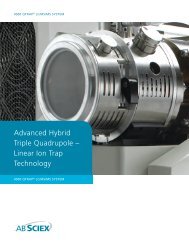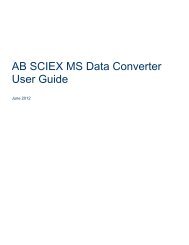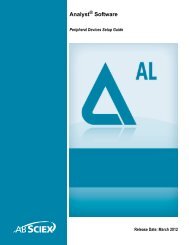Analyst Software Reference Guide - AB Sciex
Analyst Software Reference Guide - AB Sciex
Analyst Software Reference Guide - AB Sciex
- No tags were found...
Create successful ePaper yourself
Turn your PDF publications into a flip-book with our unique Google optimized e-Paper software.
Terms and ConceptsTable 1-12 Internal Standards Column Fields (Continued)FieldIS Retention TimeIS Expected Retention TimeIS Retention Time WindowIS Centroid LocationIS Start ScanIS Start TimeIS Stop ScanIS Stop TimeIS Integration TypeIS Signal to NoiseIS Peak WidthIS UV RangeIS UV ChannelIS Peak Width at 50 Percent (min.)IS Baseline Slope (%/min.)IS Peak AsymmetryIS Processing AlgIS Integration QualityDefinitionThe chromatographic retention time as determined by thesoftware.The retention time of the representative sample. Takenfrom the quantitation method.The retention time window as specified in the quantitationmethod.The intensity-weighted average retention time for theanalyte. The peak areas up to and after this time areidentified.The cycle number associated with the period/experimentcombination where the peak begins.The time associated with the period/experimentcombination where the peak begins.The cycle number associated with the period/experimentcombination where the peak ends.The time associated with the period/experimentcombination where the peak ends.The method by which the baseline was found andintegrated when the peak was found. The types are:manual, automatic (Baseline-to-Baseline, Valley,Exponential Skim, and Exponential Child).The signal-to-noise ratio of the peak.The ratio of the peak height to its width.The UV range of the internal standard.The UV channel of the internal standard.A read-only column displaying the peak width at 50% ofpeak height.A read-only column displaying the slope of the baseline.A read-only column displaying the peak asymmetry whichis calculated by the following formula:[(Peak End Time) – (Retention Time)] / [(Retention Time) –(Peak Start Time)]Values near 1.0 indicate symmetric peaks, values greaterthan 1.0 indicate tailing peaks, and values less than 1.0indicate fronting peaks.A read-only column displaying the processing algorithmused.The Integration Quality Index indicates how well thepeak is integrated. Values closer to 1 indicate wellintegratedpeaks and values closer to 0 indicate poorlyintegrated peaks.44 Release Date: August 2011



